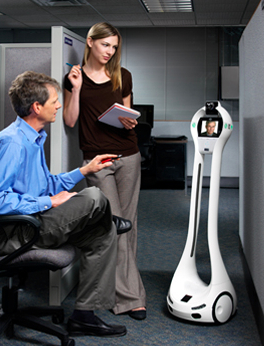Telepresence
Contents
[hide]Definition
"Telepresence refers to a set of technologies which allow a person to feel as if they were present, to give the appearance that they were present, or to have an effect, via telerobotics, at a place other than their true location" [1]. "A popular application is found in telepresence videoconferencing, a higher level of videotelephony which deploys greater technical sophistication and improved fidelity of both video and audio than in traditional videoconferencing" [2].
Examples
Telepresence Eye
“A Philco engineer named Steve Moulton made a nice telepresence eye. He mounted a TV camera atop a building and wore a helmet so that when he moved his head, the camera on top of the building moved, and so did a viewing screen attached to the helmet. Wearing this helmet you have the feeling of being on top of the building and looking around Philadelphia. If you “lean over” it’s kind of creep. But the most sensational thing Moulton did was to put a two-to-one ratio on the neck, so that when you turn your head 30 degrees, the mounted camera turns 60 degrees: you feel as if you had a rubber neck, as if you could turn your “head” completely around” (Clark, 93).

Telepresence in the Workplace
Telepresence robots enable mobility and participation by a remote entity, enabling one to be present and mobile in and throughout a distant location. One can see, hear, talk, interact, and move around just as if one were there. Unlike videoconferences where two or more people are meeting through TV monitors or PCs where people on both sides of the call must be sitting in front the camera, a remote participant can move completely independent of those in the remote location.
LongPen
"The LongPen is a remote signing device conceived by writer Margaret Atwood. It allows someone to write in ink anywhere in the world via tablet PC and the internet" [3]. It allows audio and video conversation between the fan and author while a book is being signed remotely" [4].
Autopen
"An autopen is a machine for the automatic signing of a signature as an autograph. The reason for employing an autopen is typically emotive, intended to form a compromise between making every signature by hand, and printing a reproduction of the signature, which can be felt impersonal by the recipient" [5].
Telepresence and Twitter HQ
Twitter employee Rael Dornfest lives in Portland and works in San Francisco. He regularly uses a telepresence bot to attend meetings at Twitter headquarters while he is at home in Portland. Twitter employees have a fondness for his bot and electronic extension of self into their space, and there are many curious stories where rooms have become quiet while one robot talks to a talking head on Skype.
Rael says he is pleased with the experience [6], as he doesn't have to tell someone to turn the laptop while he Skypes into a conference call so that he can see who is talking. Rather, he can simply use the controls on the bot to turn his virtual head to meet the speaker.
Chit Chat Club
An early suggestion of telepresence bots for collaboration was ChitChatClub created by the Sociable Media Group at MIT Media Lab"The avatar chair is designed to let the remote participant be a real presence at the table. It is human scale: the monitor is at ordinary head height at the table and the face in it is human scale. The chest area of the avatar chair houses a screen to display text that an online user types in. For people in the physical space, this is like reading an ever-changing t-shirt" [7].
"A small camera mounted on the avatar's head allows the remote visitor to see others at the table. The chair - and thus camera & monitor - can swivel" [8].
In Chit Chat Club online participants do not have robotic control of their chair, "leaving it up to the people physically present to facilitate the movement of the avatars". While this seems like an obvious limitation and deficit of the system, the project counters this thought by pointing out that, "what the virtual visitor can see is negotiated with those who are physically present" [9].
This makes Chit Chat Club no more useful than having a computer with Skype, or an iPhone with Facetime, as the constraint of being unable to change view unless one is moved or carried is a large part of the experience. Current telepresence robots remove this limitation because they allow their remote users to move their extended technosocial self to opportunities and spaces of action, instead of waiting to be carried to those spaces. This allows those present at a site of action to simply act autonomously without having to worry about taking care of the needs of a "paralyzed" remote participant. Current mobile telepresence bots thus free the remote individual from being constrained to one space and viewpoint.